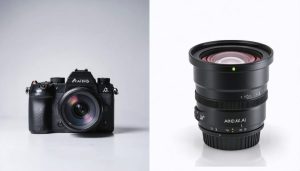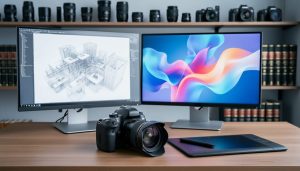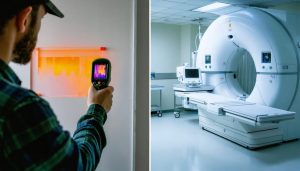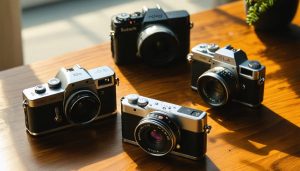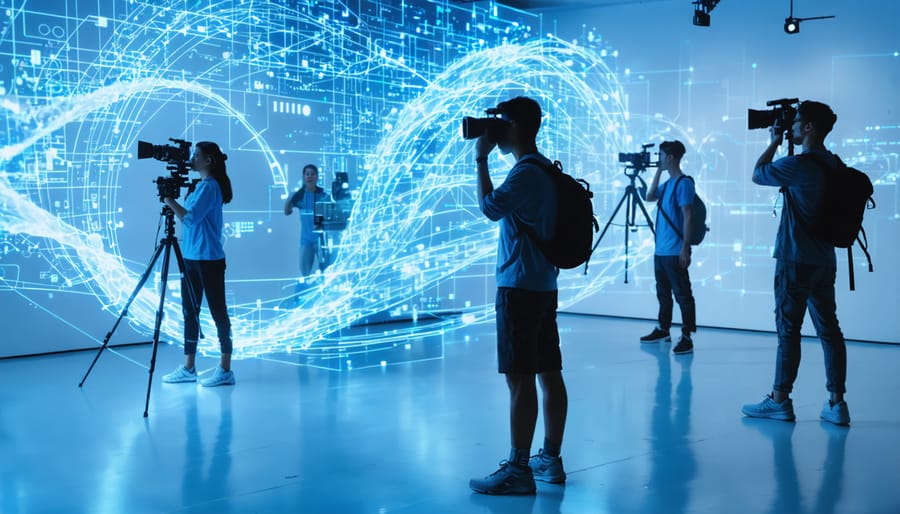
The fusion of AI photography technology with gimbal stabilization has revolutionized how creators capture smooth, professional-grade footage. Modern AI-powered gimbals anticipate movement patterns, automatically track subjects, and adjust stabilization parameters in real-time—capabilities that were once exclusive to high-end production equipment. These smart stabilizers use advanced algorithms to analyze motion data thousands of times per second, delivering buttery-smooth footage even in challenging shooting conditions. Whether you’re a solo content creator tracking fast-moving subjects or a professional cinematographer executing complex camera movements, AI gimbals represent a quantum leap in camera stabilization technology. They’re not just tools; they’re intelligent creative partners that enhance your visual storytelling capabilities while simplifying the technical complexities of smooth camera movement.
How AI is Revolutionizing Gimbal Technology
Smart Subject Tracking
Smart subject tracking represents one of the most impressive features of AI-powered gimbals, using advanced algorithms to recognize and follow subjects with remarkable precision. Unlike traditional gimbals that rely on basic motion detection, AI-enabled tracking can identify specific subjects – whether they’re people, vehicles, or animals – and maintain focus even in challenging conditions.
The system works by continuously analyzing the frame in real-time, creating a virtual boundary around the chosen subject. When your subject moves, the gimbal automatically adjusts its motors to keep them centered in the frame. What’s particularly impressive is how these systems can maintain tracking even when subjects temporarily disappear behind obstacles or move through crowds.
Many modern AI gimbals offer multiple tracking modes, including face tracking for vloggers, full-body tracking for sports, and even object tracking for product shots. Some advanced models can even predict movement patterns, resulting in smoother footage when following fast-moving subjects. This intelligent tracking capability means creators can focus more on their creative vision and less on manual camera operation, opening up new possibilities for dynamic, single-operator shooting scenarios.
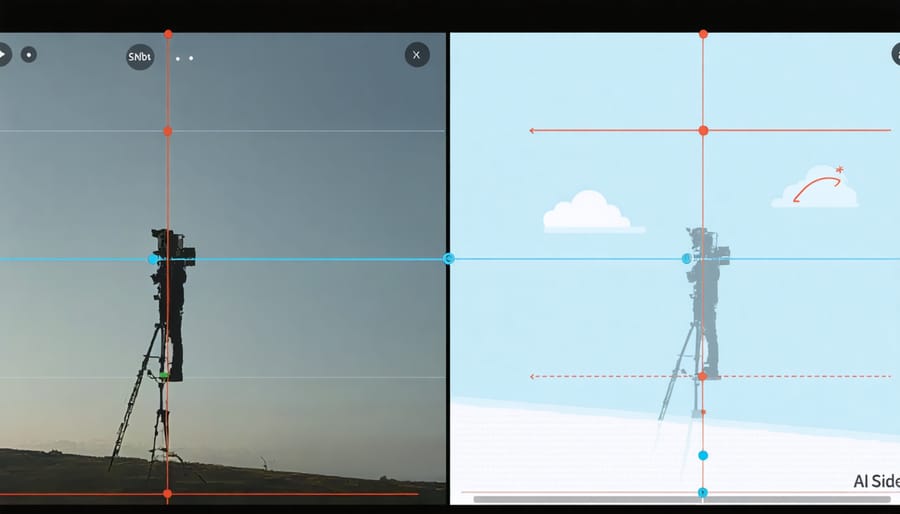
Gesture Control and Scene Recognition
One of the most impressive features of AI-powered gimbals is their ability to recognize and respond to hand gestures, revolutionizing how creators control their camera movements. With simple hand signals, you can start recording, track subjects, or switch between different shooting modes without touching the device – perfect for self-recording or when your hands are occupied with other gear.
The AI’s scene recognition capabilities take your shooting experience to the next level. These smart gimbals can automatically identify different shooting scenarios – whether you’re capturing fast-moving sports, recording a walk-and-talk vlog, or shooting a dramatic panorama – and adjust their stabilization parameters accordingly. For instance, when filming sports, the gimbal automatically switches to a more responsive mode with faster tracking, while it opts for smoother, more cinematic movements during landscape shots.
What’s particularly fascinating is how these systems learn and adapt to your shooting style over time. The more you use the gimbal, the better it becomes at predicting your intended movements and adjusting its behavior to match your preferences, creating a truly personalized shooting experience.
Game-Changing Features for Photographers
Predictive Stabilization
One of the most remarkable features of AI-powered gimbals is their ability to predict and adapt to movement patterns before they occur. Unlike traditional gimbals that simply react to motion, AI-enabled stabilization systems analyze movement data in real-time, creating a predictive model of how the camera is likely to move next.
Think of it as having a virtual assistant that learns your filming style. When you’re tracking a subject, the AI recognizes patterns in your movement and adjusts the motors milliseconds before you actually make the motion. This predictive capability is particularly valuable when capturing fast-moving subjects or walking shots, making these essential camera accessories for dynamic shooting situations.
The AI processes multiple data points simultaneously, including acceleration, velocity, and historical movement patterns. For instance, if you’re following a runner, the system anticipates the natural bobbing motion of your walk and compensates accordingly, resulting in remarkably smooth footage that would be difficult to achieve with conventional stabilization methods.
This smart prediction also helps conserve battery life by optimizing motor movements and reducing unnecessary corrections. The system becomes more efficient over time as it learns your shooting style, making each subsequent shoot smoother and more professional-looking than the last.
Automated Shot Modes
Modern AI-powered gimbals come equipped with an impressive array of automated shot modes that revolutionize how creators capture content. These intelligent camera automation features transform complex cinematographic techniques into one-tap operations, making professional-looking shots accessible to creators of all skill levels.
Popular automated modes include object tracking, where the gimbal intelligently follows your subject while maintaining smooth movement and perfect framing. The AI anticipates subject movement and adjusts in real-time, whether you’re filming fast-moving sports or walking alongside your subject for a documentary-style shot.
Time-lapse and hyperlapse modes benefit significantly from AI enhancement, automatically calculating movement speeds and trajectories to create stunning motion sequences. The gimbal smoothly pans and transitions between keyframes while maintaining consistent exposure and focus throughout the sequence.
Gesture control adds another layer of creative possibility, allowing solo creators to trigger recording or tracking modes with simple hand movements. This is particularly useful for vloggers and content creators who frequently film themselves.
Portrait mode tracking has become increasingly sophisticated, with AI algorithms that recognize facial features and maintain optimal framing even as subjects move or change expression. Some advanced models even incorporate smart composition guides based on cinematography principles, helping users achieve more visually appealing results with minimal effort.
Real-World Performance and Applications
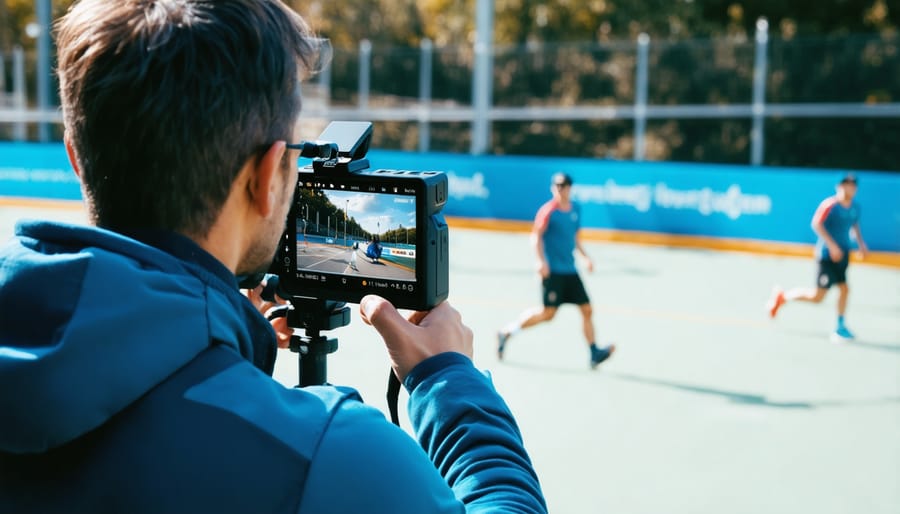
Action and Sports Photography
Action and sports photography present unique challenges that AI-powered gimbals are specifically designed to tackle. When you’re tracking fast-moving subjects like athletes, vehicles, or wildlife, traditional stabilization methods often fall short. This is where AI gimbals truly shine, offering predictive tracking and intelligent subject recognition that keeps your shots steady and your subject perfectly framed.
The real game-changer is how AI gimbals anticipate movement patterns. Instead of merely reacting to motion, they use advanced algorithms to predict where your subject is heading, adjusting the stabilization accordingly. For instance, when photographing a soccer match, the gimbal can track a player running across the field while maintaining smooth movement and keeping them centered in the frame.
These smart stabilizers also excel at handling sudden direction changes. Whether you’re capturing skateboarding tricks, motorsports, or dance performances, the AI adapts in milliseconds to maintain composition. Many models offer sport-specific tracking modes that are fine-tuned for particular activities, ensuring optimal performance for your specific shooting needs.
Another impressive feature is the ability to maintain focus on your subject even when obstacles briefly obstruct the view. If you’re photographing a mountain biker through trees, the AI remembers your subject and quickly reacquires tracking once they emerge from behind obstacles.
For sports photographers, this technology means spending less time fighting with equipment and more time focusing on capturing the perfect moment. The combination of sophisticated motion prediction, rapid response times, and intelligent tracking makes AI gimbals an invaluable tool for action photography, delivering professional-quality results even in the most challenging shooting conditions.
Vlogging and Content Creation
For content creators and vloggers, AI-powered gimbals are revolutionizing the way social media content is produced. These smart stabilizers can detect and track subjects automatically, allowing solo creators to film themselves without a camera operator. Imagine walking down a street while vlogging – the AI gimbal keeps you perfectly centered and in focus, adjusting smoothly as you move.
The real game-changer for social media creators is the gesture control feature. With simple hand movements, you can start recording, switch tracking modes, or even trigger pre-programmed movements for dynamic shots. This means you can create professional-looking content without breaking your flow or constantly adjusting equipment.
AI gimbals excel at creating those signature social media movements that viewers love. Whether it’s a smooth reveal of a location, an orbit shot around a product, or a dramatic transition, these devices can execute complex camera movements consistently. Some models even offer scene-specific presets optimized for different content types, from beauty tutorials to dance videos.
Time-saving features are particularly valuable for daily content creators. The automated tracking and stabilization mean fewer takes and less time spent editing shaky footage. Many AI gimbals also integrate directly with popular social platforms, allowing for quick sharing and live streaming with professional-level stabilization.
For storytelling on platforms like TikTok and Instagram Reels, AI gimbals offer creative possibilities through features like motion timelapse and programmed multi-point movements. These tools help creators stand out in crowded feeds with polished, engaging content that looks professionally produced, even when filming solo.
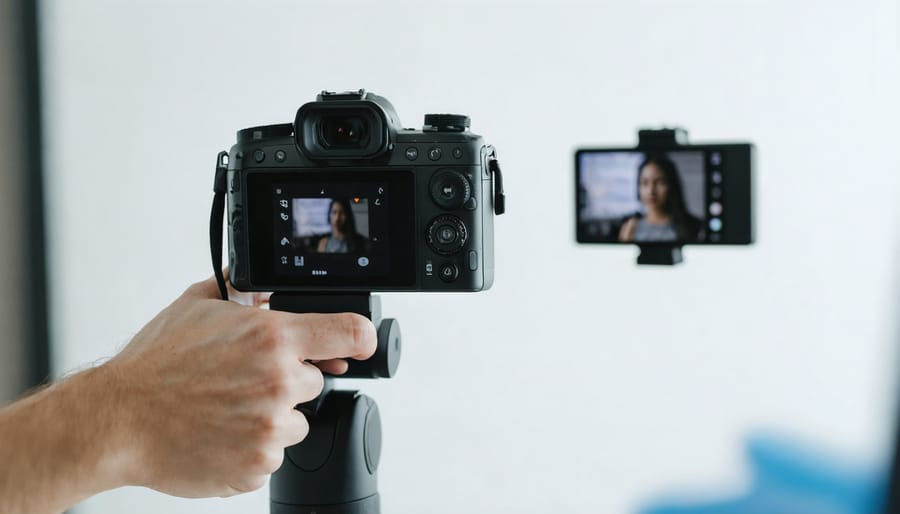
Current Limitations and Future Prospects
While AI-powered gimbals have made remarkable strides in stabilization and subject tracking, they still face several notable limitations. Current AI systems occasionally struggle with rapid subject movements or complex shooting scenarios, particularly in low-light conditions or crowded environments. Battery life remains a concern, as the additional processing power required for AI features can significantly impact operational time compared to traditional gimbals.
Processing delays, though minimal, can sometimes create a slight lag between subject movement and gimbal response, especially when dealing with multiple tracking points or sophisticated motion prediction algorithms. Additionally, the learning curve for maximizing AI features can be steeper than expected, particularly for users transitioning from manual gimbals.
However, the future of camera technology looks incredibly promising for AI gimbals. Manufacturers are actively developing more efficient processors and advanced algorithms that could virtually eliminate response lag while reducing power consumption. We’re likely to see improvements in multi-subject tracking capabilities and more intuitive gesture controls.
Emerging developments in machine learning suggest that future AI gimbals might adapt to individual shooting styles, learning from user preferences and shooting patterns to deliver more personalized stabilization. Integration with smartphone apps is expected to become more seamless, offering enhanced creative control and real-time adjustment capabilities.
Perhaps most exciting is the potential for AI gimbals to incorporate predictive movement analysis, anticipating subject motion before it happens and preparing for smooth transitions automatically. This could revolutionize action photography and dynamic filming scenarios, making complex shots more accessible to creators at all skill levels.
As these technologies mature, we can expect to see more affordable options entering the market, making professional-grade stabilization available to a broader range of content creators and enthusiasts.
AI-powered gimbals represent a significant leap forward in photography and videography technology, combining traditional stabilization with intelligent features that were once thought impossible. These innovative devices have transformed how creators capture moments, offering unprecedented precision and creative possibilities through automated tracking, gesture control, and sophisticated motion prediction algorithms.
For photographers and videographers considering an AI gimbal investment, the decision largely depends on your specific needs and workflow. If you frequently shoot dynamic subjects, create content solo, or need reliable tracking capabilities, an AI gimbal can be an invaluable tool that significantly enhances your production value. However, beginners might want to start with entry-level models to familiarize themselves with the basic features before advancing to more sophisticated options.
When selecting an AI gimbal, consider factors such as battery life, payload capacity, and compatibility with your existing equipment. Look for models offering software updates and a robust app ecosystem, as these features ensure your investment remains valuable as technology evolves. While AI-powered gimbals generally command higher prices than their traditional counterparts, the added capabilities and time-saving features often justify the investment for serious content creators.
As AI technology continues to advance, we can expect even more impressive features and capabilities in future gimbal systems. Whether you’re a professional photographer or an enthusiastic hobbyist, AI gimbals offer a compelling blend of stability, intelligence, and creative freedom that can elevate your visual storytelling to new heights.





